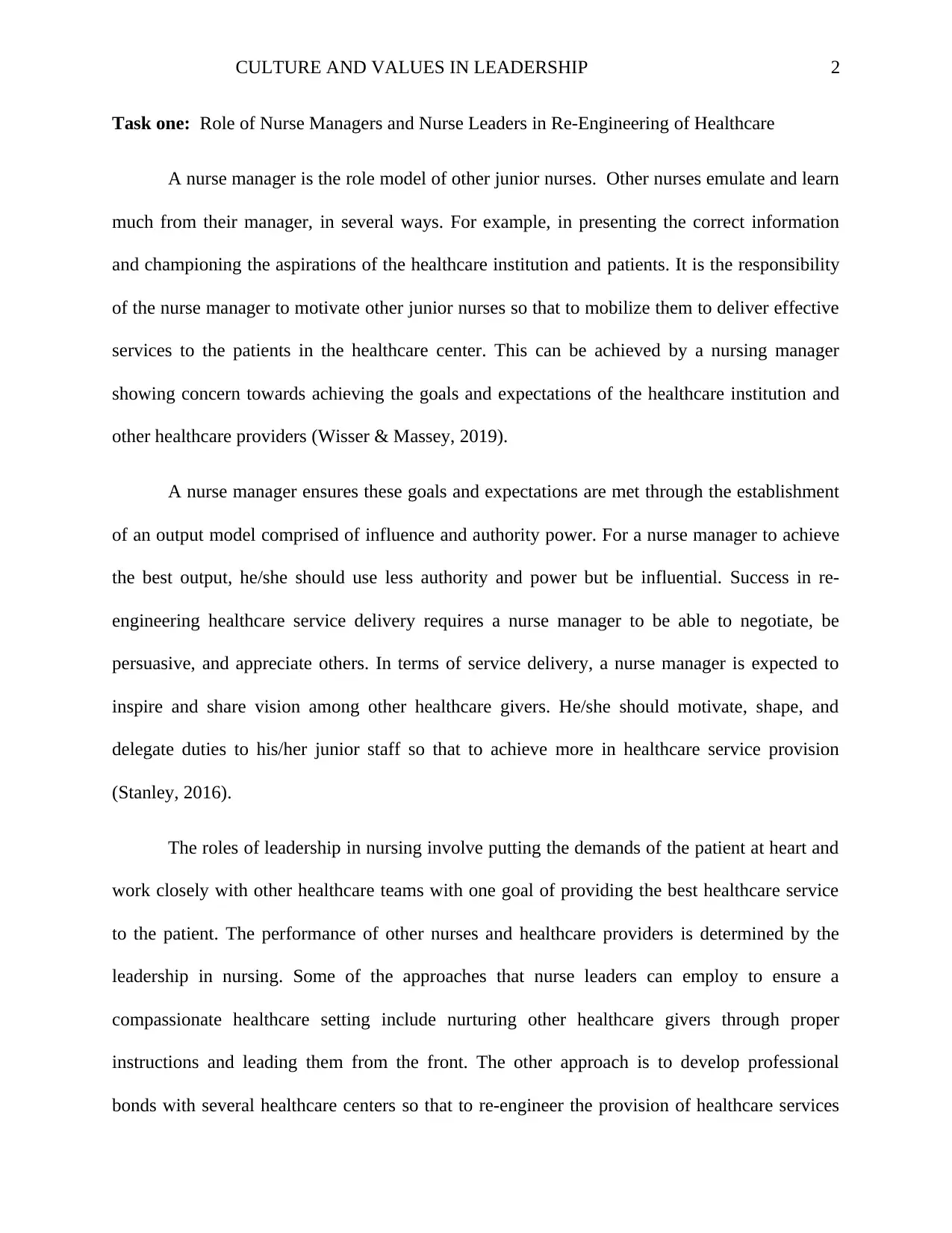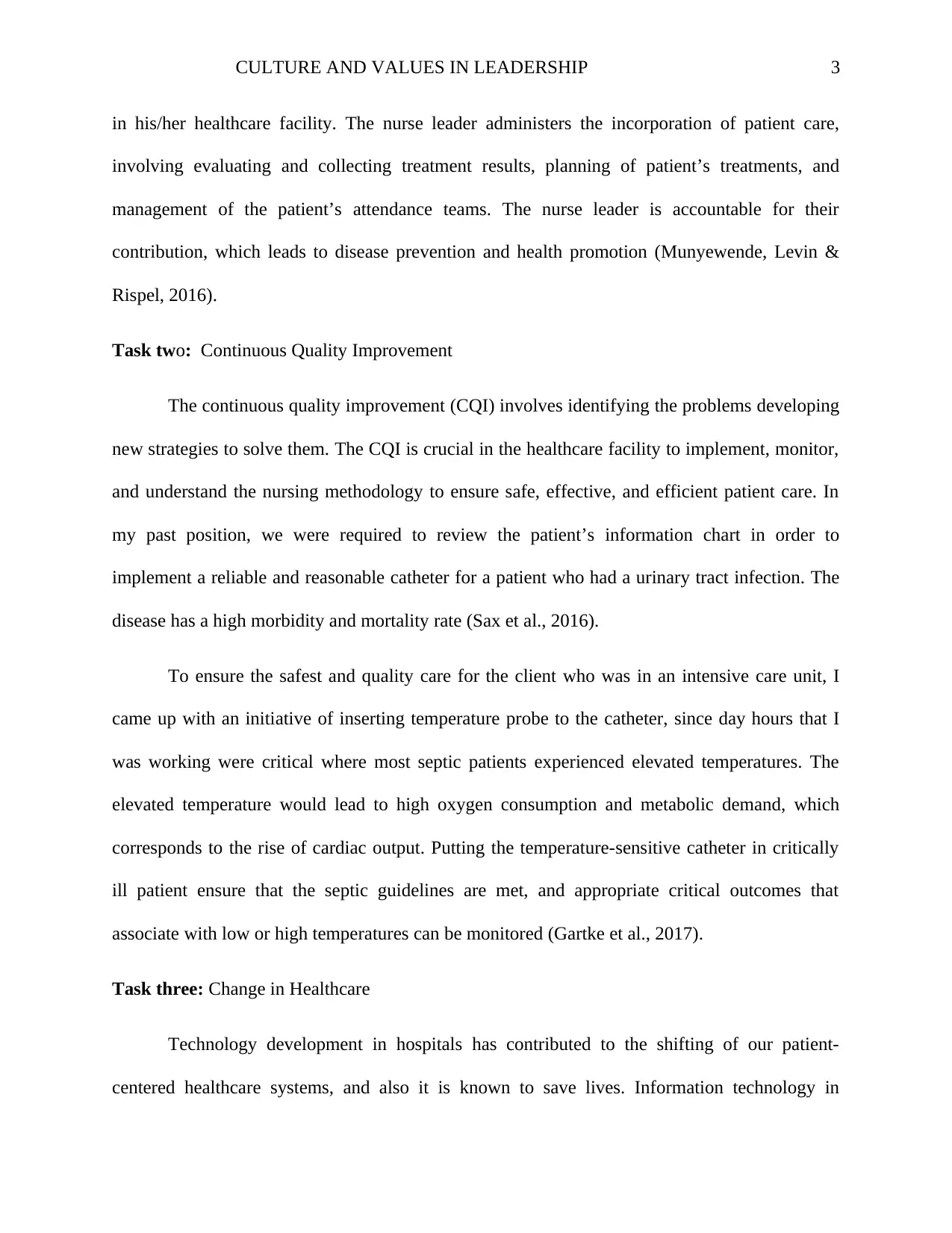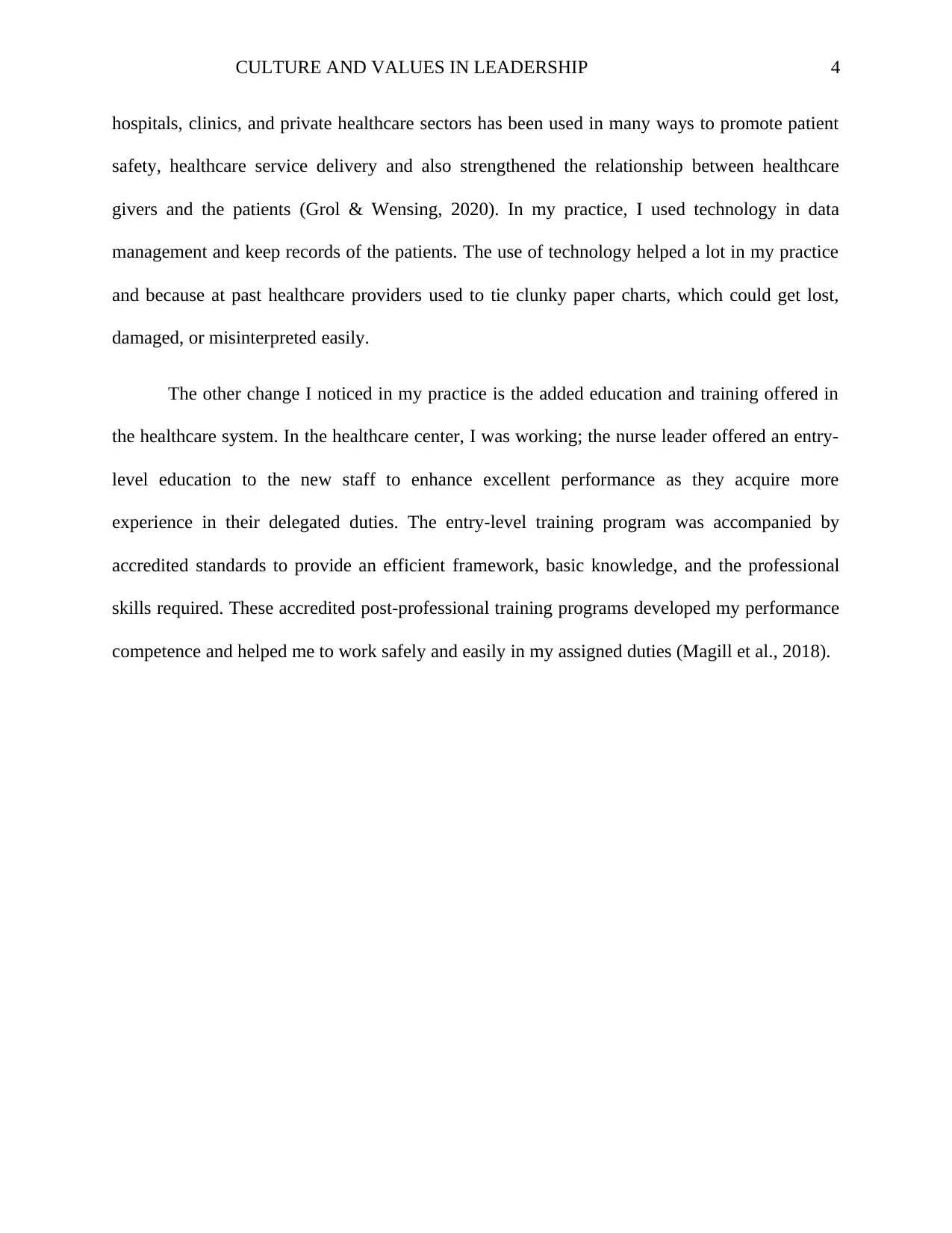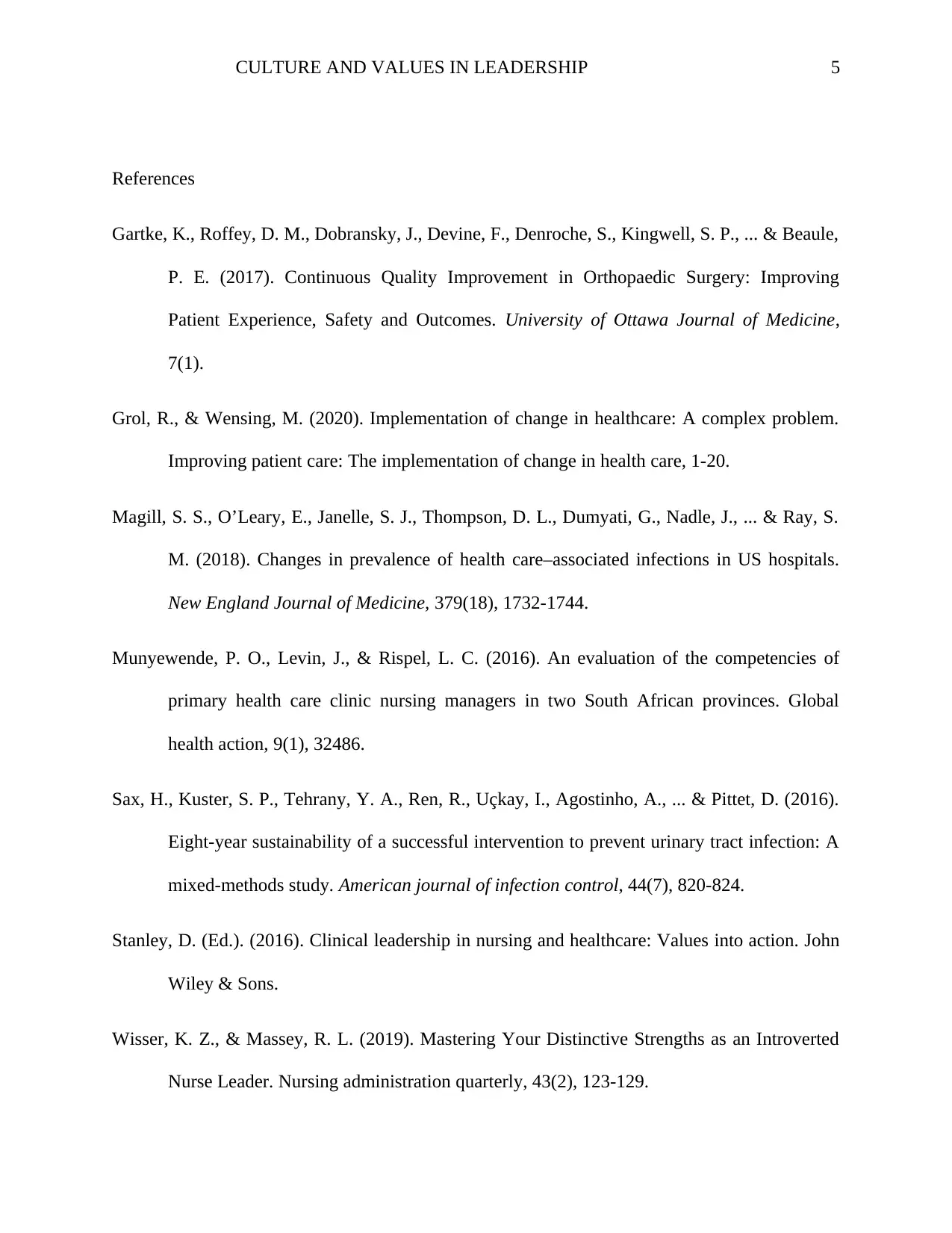Culture and Values in Leadership: Impact on Healthcare Quality
VerifiedAdded on 2022/08/16
|5
|1219
|17
Essay
AI Summary
This essay examines the crucial role of culture and values in healthcare leadership, focusing on the responsibilities of nurse managers and leaders in re-engineering healthcare systems. It emphasizes the importance of influence and effective communication for nurse managers to motivate their teams and achieve organizational goals. The essay also discusses the implementation of continuous quality improvement (CQI) strategies, using a practical example of managing urinary tract infections with temperature-sensitive catheters. Furthermore, it addresses the impact of technological advancements and the importance of continuous education and training in enhancing healthcare service delivery and patient safety. The essay concludes by highlighting how these elements collectively contribute to a more patient-centered and efficient healthcare environment.

Running head: CULTURE AND VALUES IN LEADERSHIP 1
Culture and Values in Healthcare
Student:
Professor:
Institution Affiliation:
Date:
Culture and Values in Healthcare
Student:
Professor:
Institution Affiliation:
Date:
Paraphrase This Document
Need a fresh take? Get an instant paraphrase of this document with our AI Paraphraser

CULTURE AND VALUES IN LEADERSHIP 2
Task one: Role of Nurse Managers and Nurse Leaders in Re-Engineering of Healthcare
A nurse manager is the role model of other junior nurses. Other nurses emulate and learn
much from their manager, in several ways. For example, in presenting the correct information
and championing the aspirations of the healthcare institution and patients. It is the responsibility
of the nurse manager to motivate other junior nurses so that to mobilize them to deliver effective
services to the patients in the healthcare center. This can be achieved by a nursing manager
showing concern towards achieving the goals and expectations of the healthcare institution and
other healthcare providers (Wisser & Massey, 2019).
A nurse manager ensures these goals and expectations are met through the establishment
of an output model comprised of influence and authority power. For a nurse manager to achieve
the best output, he/she should use less authority and power but be influential. Success in re-
engineering healthcare service delivery requires a nurse manager to be able to negotiate, be
persuasive, and appreciate others. In terms of service delivery, a nurse manager is expected to
inspire and share vision among other healthcare givers. He/she should motivate, shape, and
delegate duties to his/her junior staff so that to achieve more in healthcare service provision
(Stanley, 2016).
The roles of leadership in nursing involve putting the demands of the patient at heart and
work closely with other healthcare teams with one goal of providing the best healthcare service
to the patient. The performance of other nurses and healthcare providers is determined by the
leadership in nursing. Some of the approaches that nurse leaders can employ to ensure a
compassionate healthcare setting include nurturing other healthcare givers through proper
instructions and leading them from the front. The other approach is to develop professional
bonds with several healthcare centers so that to re-engineer the provision of healthcare services
Task one: Role of Nurse Managers and Nurse Leaders in Re-Engineering of Healthcare
A nurse manager is the role model of other junior nurses. Other nurses emulate and learn
much from their manager, in several ways. For example, in presenting the correct information
and championing the aspirations of the healthcare institution and patients. It is the responsibility
of the nurse manager to motivate other junior nurses so that to mobilize them to deliver effective
services to the patients in the healthcare center. This can be achieved by a nursing manager
showing concern towards achieving the goals and expectations of the healthcare institution and
other healthcare providers (Wisser & Massey, 2019).
A nurse manager ensures these goals and expectations are met through the establishment
of an output model comprised of influence and authority power. For a nurse manager to achieve
the best output, he/she should use less authority and power but be influential. Success in re-
engineering healthcare service delivery requires a nurse manager to be able to negotiate, be
persuasive, and appreciate others. In terms of service delivery, a nurse manager is expected to
inspire and share vision among other healthcare givers. He/she should motivate, shape, and
delegate duties to his/her junior staff so that to achieve more in healthcare service provision
(Stanley, 2016).
The roles of leadership in nursing involve putting the demands of the patient at heart and
work closely with other healthcare teams with one goal of providing the best healthcare service
to the patient. The performance of other nurses and healthcare providers is determined by the
leadership in nursing. Some of the approaches that nurse leaders can employ to ensure a
compassionate healthcare setting include nurturing other healthcare givers through proper
instructions and leading them from the front. The other approach is to develop professional
bonds with several healthcare centers so that to re-engineer the provision of healthcare services

CULTURE AND VALUES IN LEADERSHIP 3
in his/her healthcare facility. The nurse leader administers the incorporation of patient care,
involving evaluating and collecting treatment results, planning of patient’s treatments, and
management of the patient’s attendance teams. The nurse leader is accountable for their
contribution, which leads to disease prevention and health promotion (Munyewende, Levin &
Rispel, 2016).
Task two: Continuous Quality Improvement
The continuous quality improvement (CQI) involves identifying the problems developing
new strategies to solve them. The CQI is crucial in the healthcare facility to implement, monitor,
and understand the nursing methodology to ensure safe, effective, and efficient patient care. In
my past position, we were required to review the patient’s information chart in order to
implement a reliable and reasonable catheter for a patient who had a urinary tract infection. The
disease has a high morbidity and mortality rate (Sax et al., 2016).
To ensure the safest and quality care for the client who was in an intensive care unit, I
came up with an initiative of inserting temperature probe to the catheter, since day hours that I
was working were critical where most septic patients experienced elevated temperatures. The
elevated temperature would lead to high oxygen consumption and metabolic demand, which
corresponds to the rise of cardiac output. Putting the temperature-sensitive catheter in critically
ill patient ensure that the septic guidelines are met, and appropriate critical outcomes that
associate with low or high temperatures can be monitored (Gartke et al., 2017).
Task three: Change in Healthcare
Technology development in hospitals has contributed to the shifting of our patient-
centered healthcare systems, and also it is known to save lives. Information technology in
in his/her healthcare facility. The nurse leader administers the incorporation of patient care,
involving evaluating and collecting treatment results, planning of patient’s treatments, and
management of the patient’s attendance teams. The nurse leader is accountable for their
contribution, which leads to disease prevention and health promotion (Munyewende, Levin &
Rispel, 2016).
Task two: Continuous Quality Improvement
The continuous quality improvement (CQI) involves identifying the problems developing
new strategies to solve them. The CQI is crucial in the healthcare facility to implement, monitor,
and understand the nursing methodology to ensure safe, effective, and efficient patient care. In
my past position, we were required to review the patient’s information chart in order to
implement a reliable and reasonable catheter for a patient who had a urinary tract infection. The
disease has a high morbidity and mortality rate (Sax et al., 2016).
To ensure the safest and quality care for the client who was in an intensive care unit, I
came up with an initiative of inserting temperature probe to the catheter, since day hours that I
was working were critical where most septic patients experienced elevated temperatures. The
elevated temperature would lead to high oxygen consumption and metabolic demand, which
corresponds to the rise of cardiac output. Putting the temperature-sensitive catheter in critically
ill patient ensure that the septic guidelines are met, and appropriate critical outcomes that
associate with low or high temperatures can be monitored (Gartke et al., 2017).
Task three: Change in Healthcare
Technology development in hospitals has contributed to the shifting of our patient-
centered healthcare systems, and also it is known to save lives. Information technology in
⊘ This is a preview!⊘
Do you want full access?
Subscribe today to unlock all pages.

Trusted by 1+ million students worldwide

CULTURE AND VALUES IN LEADERSHIP 4
hospitals, clinics, and private healthcare sectors has been used in many ways to promote patient
safety, healthcare service delivery and also strengthened the relationship between healthcare
givers and the patients (Grol & Wensing, 2020). In my practice, I used technology in data
management and keep records of the patients. The use of technology helped a lot in my practice
and because at past healthcare providers used to tie clunky paper charts, which could get lost,
damaged, or misinterpreted easily.
The other change I noticed in my practice is the added education and training offered in
the healthcare system. In the healthcare center, I was working; the nurse leader offered an entry-
level education to the new staff to enhance excellent performance as they acquire more
experience in their delegated duties. The entry-level training program was accompanied by
accredited standards to provide an efficient framework, basic knowledge, and the professional
skills required. These accredited post-professional training programs developed my performance
competence and helped me to work safely and easily in my assigned duties (Magill et al., 2018).
hospitals, clinics, and private healthcare sectors has been used in many ways to promote patient
safety, healthcare service delivery and also strengthened the relationship between healthcare
givers and the patients (Grol & Wensing, 2020). In my practice, I used technology in data
management and keep records of the patients. The use of technology helped a lot in my practice
and because at past healthcare providers used to tie clunky paper charts, which could get lost,
damaged, or misinterpreted easily.
The other change I noticed in my practice is the added education and training offered in
the healthcare system. In the healthcare center, I was working; the nurse leader offered an entry-
level education to the new staff to enhance excellent performance as they acquire more
experience in their delegated duties. The entry-level training program was accompanied by
accredited standards to provide an efficient framework, basic knowledge, and the professional
skills required. These accredited post-professional training programs developed my performance
competence and helped me to work safely and easily in my assigned duties (Magill et al., 2018).
Paraphrase This Document
Need a fresh take? Get an instant paraphrase of this document with our AI Paraphraser

CULTURE AND VALUES IN LEADERSHIP 5
References
Gartke, K., Roffey, D. M., Dobransky, J., Devine, F., Denroche, S., Kingwell, S. P., ... & Beaule,
P. E. (2017). Continuous Quality Improvement in Orthopaedic Surgery: Improving
Patient Experience, Safety and Outcomes. University of Ottawa Journal of Medicine,
7(1).
Grol, R., & Wensing, M. (2020). Implementation of change in healthcare: A complex problem.
Improving patient care: The implementation of change in health care, 1-20.
Magill, S. S., O’Leary, E., Janelle, S. J., Thompson, D. L., Dumyati, G., Nadle, J., ... & Ray, S.
M. (2018). Changes in prevalence of health care–associated infections in US hospitals.
New England Journal of Medicine, 379(18), 1732-1744.
Munyewende, P. O., Levin, J., & Rispel, L. C. (2016). An evaluation of the competencies of
primary health care clinic nursing managers in two South African provinces. Global
health action, 9(1), 32486.
Sax, H., Kuster, S. P., Tehrany, Y. A., Ren, R., Uçkay, I., Agostinho, A., ... & Pittet, D. (2016).
Eight-year sustainability of a successful intervention to prevent urinary tract infection: A
mixed-methods study. American journal of infection control, 44(7), 820-824.
Stanley, D. (Ed.). (2016). Clinical leadership in nursing and healthcare: Values into action. John
Wiley & Sons.
Wisser, K. Z., & Massey, R. L. (2019). Mastering Your Distinctive Strengths as an Introverted
Nurse Leader. Nursing administration quarterly, 43(2), 123-129.
References
Gartke, K., Roffey, D. M., Dobransky, J., Devine, F., Denroche, S., Kingwell, S. P., ... & Beaule,
P. E. (2017). Continuous Quality Improvement in Orthopaedic Surgery: Improving
Patient Experience, Safety and Outcomes. University of Ottawa Journal of Medicine,
7(1).
Grol, R., & Wensing, M. (2020). Implementation of change in healthcare: A complex problem.
Improving patient care: The implementation of change in health care, 1-20.
Magill, S. S., O’Leary, E., Janelle, S. J., Thompson, D. L., Dumyati, G., Nadle, J., ... & Ray, S.
M. (2018). Changes in prevalence of health care–associated infections in US hospitals.
New England Journal of Medicine, 379(18), 1732-1744.
Munyewende, P. O., Levin, J., & Rispel, L. C. (2016). An evaluation of the competencies of
primary health care clinic nursing managers in two South African provinces. Global
health action, 9(1), 32486.
Sax, H., Kuster, S. P., Tehrany, Y. A., Ren, R., Uçkay, I., Agostinho, A., ... & Pittet, D. (2016).
Eight-year sustainability of a successful intervention to prevent urinary tract infection: A
mixed-methods study. American journal of infection control, 44(7), 820-824.
Stanley, D. (Ed.). (2016). Clinical leadership in nursing and healthcare: Values into action. John
Wiley & Sons.
Wisser, K. Z., & Massey, R. L. (2019). Mastering Your Distinctive Strengths as an Introverted
Nurse Leader. Nursing administration quarterly, 43(2), 123-129.
1 out of 5
Related Documents
Your All-in-One AI-Powered Toolkit for Academic Success.
+13062052269
info@desklib.com
Available 24*7 on WhatsApp / Email
![[object Object]](/_next/static/media/star-bottom.7253800d.svg)
Unlock your academic potential
Copyright © 2020–2025 A2Z Services. All Rights Reserved. Developed and managed by ZUCOL.





